Towards Ready-to-Use Iron-Crosslinked Alginate Beads as Mesenchymal Stem Cell Carriers
Abstract
1. Introduction
2. Materials and Methods
2.1. Materials
2.2. Fabrication of Alginate Beads
2.3. Alginate Films Fabrication
2.4. Alginate Bead Characterization
2.5. Cell Culture and Seeding Procedures
2.6. Cell Behaviour Analysis
2.7. Statistical Significance
3. Results and Discussion
3.1. Iron Alginate Films Were Confirmed as More Bioactive Substrates Than Calcium Alginate Films
3.2. The M/G Chain Ratio of Alginate Has Important Effects on Bead Stability in Culture Conditions
3.3. Homogeneously Distributed Iron Alginate Beads Can Be Obtained through Electrospray
3.4. Iron Alginate Carriers Enhanced Cell Attachment and Proliferation Compared to Calcium Alginate
4. Conclusions
Author Contributions
Funding
Institutional Review Board Statement
Informed Consent Statement
Data Availability Statement
Conflicts of Interest
References
- Want, A.J.; Nienow, A.W.; Hewitt, C.J.; Coopman, K. Large-Scale Expansion and Exploitation of Pluripotent Stem Cells for Regenerative Medicine Purposes: Beyond the T Flask. Regen. Med. 2012, 7, 71–84. [Google Scholar] [CrossRef]
- Rafiq, Q.A.; Hewitt, C.J. Cell Therapies: Why Scale Matters. Pharm. Bioprocess 2015, 3, 97–99. [Google Scholar] [CrossRef]
- Baudequin, T.; Nyland, R.; Ye, H. Objectives, Benefits and Challenges of Bioreactor Systems for the Clinical-Scale Expansion of T Lymphocyte Cells. Biotechnol. Adv. 2021, 49, 107735. [Google Scholar] [CrossRef]
- dos Santos, F.F.; Andrade, P.Z.; da Silva, C.L.; Cabral, J.M.S. Bioreactor Design for Clinical-Grade Expansion of Stem Cells. Biotechnol. J. 2013, 8, 644–654. [Google Scholar] [CrossRef]
- Levine, D.W.; Wang, D.I.C.; Thilly, W.G. Optimization of Growth Surface Parameters in Microcarrier Cell Culture. Biotechnol. Bioeng. 1979, 21, 821–845. [Google Scholar] [CrossRef]
- Nguyen, L.T.B.; Odeleye, A.O.O.; Chui, C.; Baudequin, T.; Cui, Z.; Ye, H. Development of Thermo-Responsive Polycaprolactone Macrocarriers Conjugated with Poly(N-Isopropyl Acrylamide) for Cell Culture. Sci. Rep. 2019, 9, 3477. [Google Scholar] [CrossRef]
- Chui, C.-Y.; Odeleye, A.; Nguyen, L.; Kasoju, N.; Soliman, E.; Ye, H. Electrosprayed Genipin Cross-Linked Alginate-Chitosan Microcarriers for Ex Vivo Expansion of Mesenchymal Stem Cells. J. Biomed. Mater. Res. Part A 2019, 107, 122–133. [Google Scholar] [CrossRef] [PubMed]
- Schop, D.; van Dijkhuizen-Radersma, R.; Borgart, E.; Janssen, F.W.; Rozemuller, H.; Prins, H.-J.; de Bruijn, J.D. Expansion of Human Mesenchymal Stromal Cells on Microcarriers: Growth and Metabolism. J. Tissue Eng. Regen. Med. 2010, 4, 131–140. [Google Scholar] [CrossRef]
- Hewitt, C.J.; Lee, K.; Nienow, A.W.; Thomas, R.J.; Smith, M.; Thomas, C.R. Expansion of Human Mesenchymal Stem Cells on Microcarriers. Biotechnol. Lett. 2011, 33, 2325–2335. [Google Scholar] [CrossRef]
- Tsai, A.-C.; Ma, T. Expansion of Human Mesenchymal Stem Cells in a Microcarrier Bioreactor. In Bioreactors in Stem Cell Biology; Humana Press: New York, NY, USA, 2016; pp. 77–86. [Google Scholar]
- Rafiq, Q.A.; Brosnan, K.M.; Coopman, K.; Nienow, A.W.; Hewitt, C.J. Culture of Human Mesenchymal Stem Cells on Microcarriers in a 5 l Stirred-Tank Bioreactor. Biotechnol. Lett. 2013, 35, 1233–1245. [Google Scholar] [CrossRef]
- Odeleye, A.O.O.; Chui, C.-Y.; Nguyen, L.; Castrejón-Pita, A.A.; Ye, H.; Cui, Z. On the Use of 3D-Printed Flow Distributors to Control Particle Movement in a Fluidized Bed. Chem. Eng. Res. Des. 2018, 140, 194–204. [Google Scholar] [CrossRef]
- Nguyen, L.T.B.; Baudequin, T.; Cui, Z.; Ye, H. Validation and Scalability of Homemade Polycaprolactone Macrobeads Grafted with Thermo-responsive Poly( N -isopropylacrylamide) for Mesenchymal Stem Cell Expansion and Harvesting. Biotechnol. Bioeng. 2022, 119, 2345–2358. [Google Scholar] [CrossRef]
- Shekaran, A.; Lam, A.; Sim, E.; Jialing, L.; Jian, L.; Wen, J.T.P.; Chan, J.K.Y.; Choolani, M.; Reuveny, S.; Birch, W.; et al. Biodegradable ECM-Coated PCL Microcarriers Support Scalable Human Early MSC Expansion and in Vivo Bone Formation. Cytotherapy 2016, 18, 1332–1344. [Google Scholar] [CrossRef]
- Bidarra, S.J.; Barrias, C.C.; Granja, P.L. Injectable Alginate Hydrogels for Cell Delivery in Tissue Engineering. Acta Biomater. 2014, 10, 1646–1662. [Google Scholar] [CrossRef]
- Figaro, S.; Pereira, U.; Dumé, A.-S.; Rada, H.; Capone, S.; Bengrine, A.; Baze, A.; Rabenirina, E.; Semenzato, N.; Herpe, Y.-E.; et al. SUPPLIVER: Bioartificial Supply for Liver Failure. IRBM 2015, 36, 101–109. [Google Scholar] [CrossRef]
- Partovinia, A.; Vatankhah, E. Experimental Investigation into Size and Sphericity of Alginate Micro-Beads Produced by Electrospraying Technique: Operational Condition Optimization. Carbohydr. Polym. 2019, 209, 389–399. [Google Scholar] [CrossRef]
- Liu, T.; Yi, S.; Liu, G.; Hao, X.; Du, T.; Chen, J.; Meng, T.; Li, P.; Wang, Y. Aqueous Two-Phase Emulsions-Templated Tailorable Porous Alginate Beads for 3D Cell Culture. Carbohydr. Polym. 2021, 258, 117702. [Google Scholar] [CrossRef]
- Lee, K.Y.; Mooney, D.J. Alginate: Properties and Biomedical Applications. Prog. Polym. Sci. 2012, 37, 106–126. [Google Scholar] [CrossRef]
- Deepa, B.; Abraham, E.; Pothan, L.; Cordeiro, N.; Faria, M.; Thomas, S. Biodegradable Nanocomposite Films Based on Sodium Alginate and Cellulose Nanofibrils. Materials 2016, 9, 50. [Google Scholar] [CrossRef]
- Lin, H.-R.; Yeh, Y.-J. Porous Alginate/Hydroxyapatite Composite Scaffolds for Bone Tissue Engineering: Preparation, Characterization, Andin Vitro Studies. J. Biomed. Mater. Res. 2004, 71B, 52–65. [Google Scholar] [CrossRef] [PubMed]
- Sayyar, B.; Dodd, M.; Marquez-Curtis, L.; Janowska-Wieczorek, A.; Hortelano, G. Fibronectin-Alginate Microcapsules Improve Cell Viability and Protein Secretion of Encapsulated Factor IX-Engineered Human Mesenchymal Stromal Cells. Artif. Cells Nanomed. Biotechnol. 2015, 43, 318–327. [Google Scholar] [CrossRef] [PubMed]
- Machida-Sano, I.; Hirakawa, M.; Matsumoto, H.; Kamada, M.; Ogawa, S.; Satoh, N.; Namiki, H. Surface Characteristics Determining the Cell Compatibility of Ionically Cross-Linked Alginate Gels. Biomed. Mater. 2014, 9, 025007. [Google Scholar] [CrossRef]
- Machida-Sano, I.; Matsuda, Y.; Namiki, H. In Vitro Adhesion of Human Dermal Fibroblasts on Iron Cross-Linked Alginate Films. Biomed. Mater. 2009, 4, 025008. [Google Scholar] [CrossRef]
- Machida-Sano, I.; Ogawa, S.; Hirakawa, M.; Namiki, H. Evaluation of Three-Dimensional Porous Iron-Cross-Linked Alginate as a Scaffold for Cell Culture. ISRN Biomater. 2014, 2014, 375758. [Google Scholar] [CrossRef]
- Swamy, B.Y.; Yun, Y.-S. In Vitro Release of Metformin from Iron (III) Cross-Linked Alginate–Carboxymethyl Cellulose Hydrogel Beads. Int. J. Biol. Macromol. 2015, 77, 114–119. [Google Scholar] [CrossRef]
- Veres, P.; Sebők, D.; Dékány, I.; Gurikov, P.; Smirnova, I.; Fábián, I.; Kalmár, J. A Redox Strategy to Tailor the Release Properties of Fe(III)-Alginate Aerogels for Oral Drug Delivery. Carbohydr. Polym. 2018, 188, 159–167. [Google Scholar] [CrossRef]
- Privman, V.; Domanskyi, S.; Luz, R.A.S.; Guz, N.; Glasser, M.L.; Katz, E. Diffusion of Oligonucleotides from within Iron-Cross-Linked, Polyelectrolyte-Modified Alginate Beads: A Model System for Drug Release. ChemPhysChem 2016, 17, 976–984. [Google Scholar] [CrossRef]
- Cengiz, A.; Schroën, K.; Berton-Carabin, C. Lipid Oxidation in Emulsions Fortified with Iron-Loaded Alginate Beads. Foods 2019, 8, 361. [Google Scholar] [CrossRef]
- Dong, Y.; Dong, W.; Cao, Y.; Han, Z.; Ding, Z. Preparation and Catalytic Activity of Fe Alginate Gel Beads for Oxidative Degradation of Azo Dyes under Visible Light Irradiation. Catal. Today 2011, 175, 346–355. [Google Scholar] [CrossRef]
- Das, T.K.; Scott, Q.; Bezbaruah, A.N. Montmorillonite-Iron Crosslinked Alginate Beads for Aqueous Phosphate Removal. Chemosphere 2021, 281, 130837. [Google Scholar] [CrossRef]
- Narayanan, R.P.; Melman, G.; Letourneau, N.J.; Mendelson, N.L.; Melman, A. Photodegradable Iron(III) Cross-Linked Alginate Gels. Biomacromolecules 2012, 13, 2465–2471. [Google Scholar] [CrossRef]
- Smidsrod, O.; Skjakbrk, G. Alginate as Immobilization Matrix for Cells. Trends Biotechnol. 1990, 8, 71–78. [Google Scholar] [CrossRef]
- Donati, I.; Holtan, S.; Mørch, Y.A.; Borgogna, M.; Dentini, M. New Hypothesis on the Role of Alternating Sequences in Calcium−Alginate Gels. Biomacromolecules 2005, 6, 1031–1040. [Google Scholar] [CrossRef]
- Machida-Sano, I.; Ogawa, S.; Ueda, H.; Kimura, Y.; Satoh, N.; Namiki, H. Effects of Composition of Iron-Cross-Linked Alginate Hydrogels for Cultivation of Human Dermal Fibroblasts. Int. J. Biomater. 2012, 2012, 820513. [Google Scholar] [CrossRef] [PubMed]
- Yang, C.H.; Wang, M.X.; Haider, H.; Yang, J.H.; Sun, J.-Y.; Chen, Y.M.; Zhou, J.; Suo, Z. Strengthening Alginate/Polyacrylamide Hydrogels Using Various Multivalent Cations. ACS Appl. Mater. Interfaces 2013, 5, 10418–10422. [Google Scholar] [CrossRef] [PubMed]
- van Hoogmoed, C.G.; Busscher, H.J.; de Vos, P. Fourier Transform Infrared Spectroscopy Studies of Alginate-PLL Capsules with Varying Compositions. J. Biomed. Mater. Res. 2003, 67A, 172–178. [Google Scholar] [CrossRef]
- Gombotz, W. Protein Release from Alginate Matrices. Adv. Drug Deliv. Rev. 1998, 31, 267–285. [Google Scholar] [CrossRef]
- Chui, C.-Y.; Bonilla-Brunner, A.; Seifert, J.; Contera, S.; Ye, H. Atomic Force Microscopy-Indentation Demonstrates That Alginate Beads Are Mechanically Stable under Cell Culture Conditions. J. Mech. Behav. Biomed. Mater. 2019, 93, 61–69. [Google Scholar] [CrossRef] [PubMed]
- Pereira, R.; Tojeira, A.; Vaz, D.C.; Mendes, A.; Bártolo, P. Preparation and Characterization of Films Based on Alginate and Aloe Vera. Int. J. Polym. Anal. Charact. 2011, 16, 449–464. [Google Scholar] [CrossRef]
- Helmiyati; Aprilliza, M. Characterization and Properties of Sodium Alginate from Brown Algae Used as an Ecofriendly Superabsorbent. IOP Conf. Ser. Mater. Sci. Eng. 2017, 188, 012019. [Google Scholar] [CrossRef]
- Rosales, E.; Iglesias, O.; Pazos, M.; Sanromán, M.A. Decolourisation of Dyes under Electro-Fenton Process Using Fe Alginate Gel Beads. J. Hazard. Mater. 2012, 213–214, 369–377. [Google Scholar] [CrossRef]
- Voo, W.-P.; Lee, B.-B.; Idris, A.; Islam, A.; Tey, B.-T.; Chan, E.-S. Production of Ultra-High Concentration Calcium Alginate Beads with Prolonged Dissolution Profile. RSC Adv. 2015, 5, 36687–36695. [Google Scholar] [CrossRef]
- Sankalia, M.G.; Mashru, R.C.; Sankalia, J.M.; Sutariya, V.B. Papain Entrapment in Alginate Beads for Stability Improvement and Site-Specific Delivery: Physicochemical Characterization and Factorial Optimization Using Neural Network Modeling. AAPS PharmSciTech 2005, 6, E209–E222. [Google Scholar] [CrossRef]
- Sartori, C.; Finch, D.S.; Ralph, B.; Gilding, K. Determination of the Cation Content of Alginate Thin Films by FTi.r. Spectroscopy. Polymer 1997, 38, 43–51. [Google Scholar] [CrossRef]
- Huang, S.-L.; Lin, Y.-S. The Size Stability of Alginate Beads by Different Ionic Crosslinkers. Adv. Mater. Sci. Eng. 2017, 2017, 9304592. [Google Scholar] [CrossRef]
- Lee, B.-B.; Ravindra, P.; Chan, E.-S. Size and Shape of Calcium Alginate Beads Produced by Extrusion Dripping. Chem. Eng. Technol. 2013, 36, 1627–1642. [Google Scholar] [CrossRef]
- Khorram, M.; Samimi, M.; Samimi, A.; Moghadam, H. Electrospray Preparation of Propranolol-Loaded Alginate Beads: Effect of Matrix Reinforcement on Loading and Release Profile. J. Appl. Polym. Sci. 2015, 132. [Google Scholar] [CrossRef]




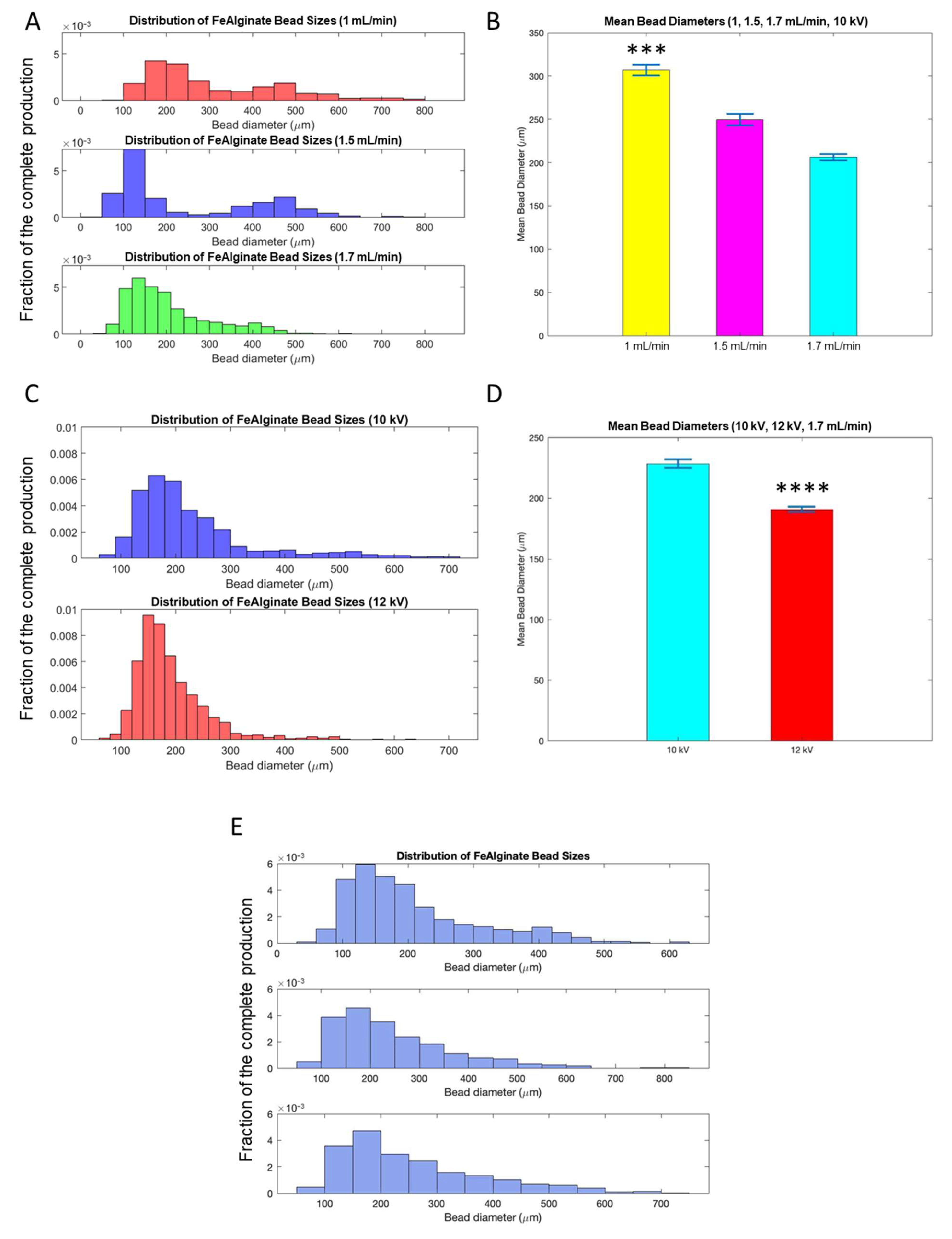
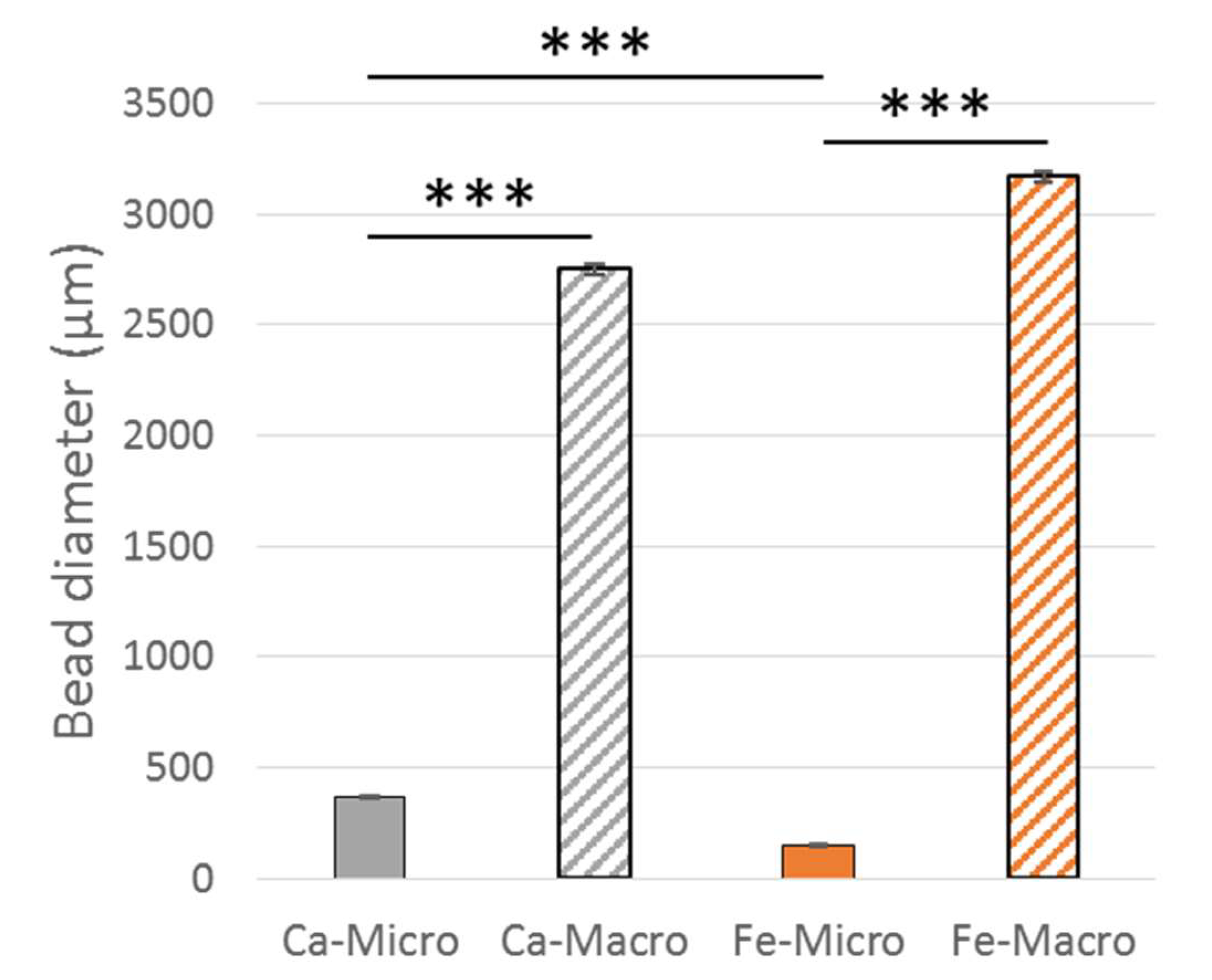
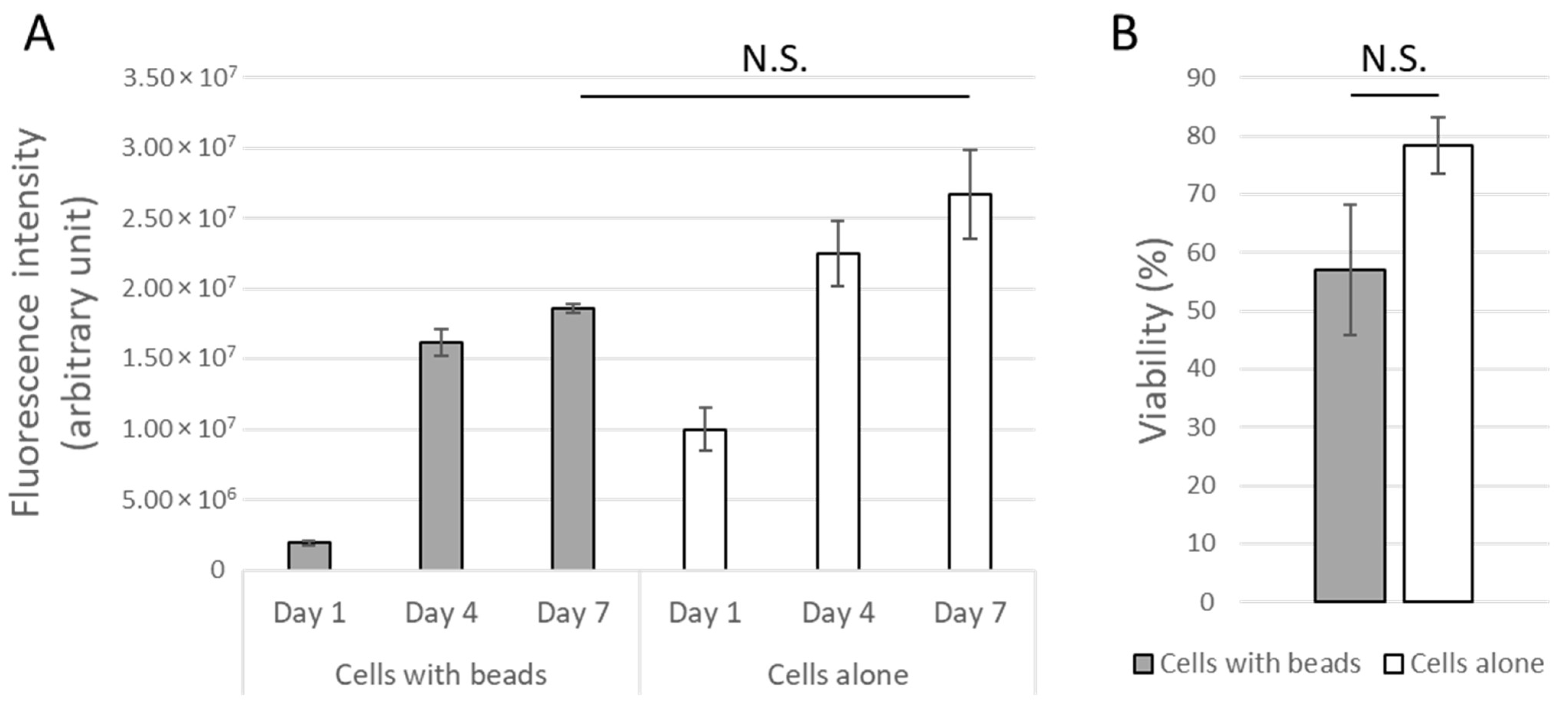
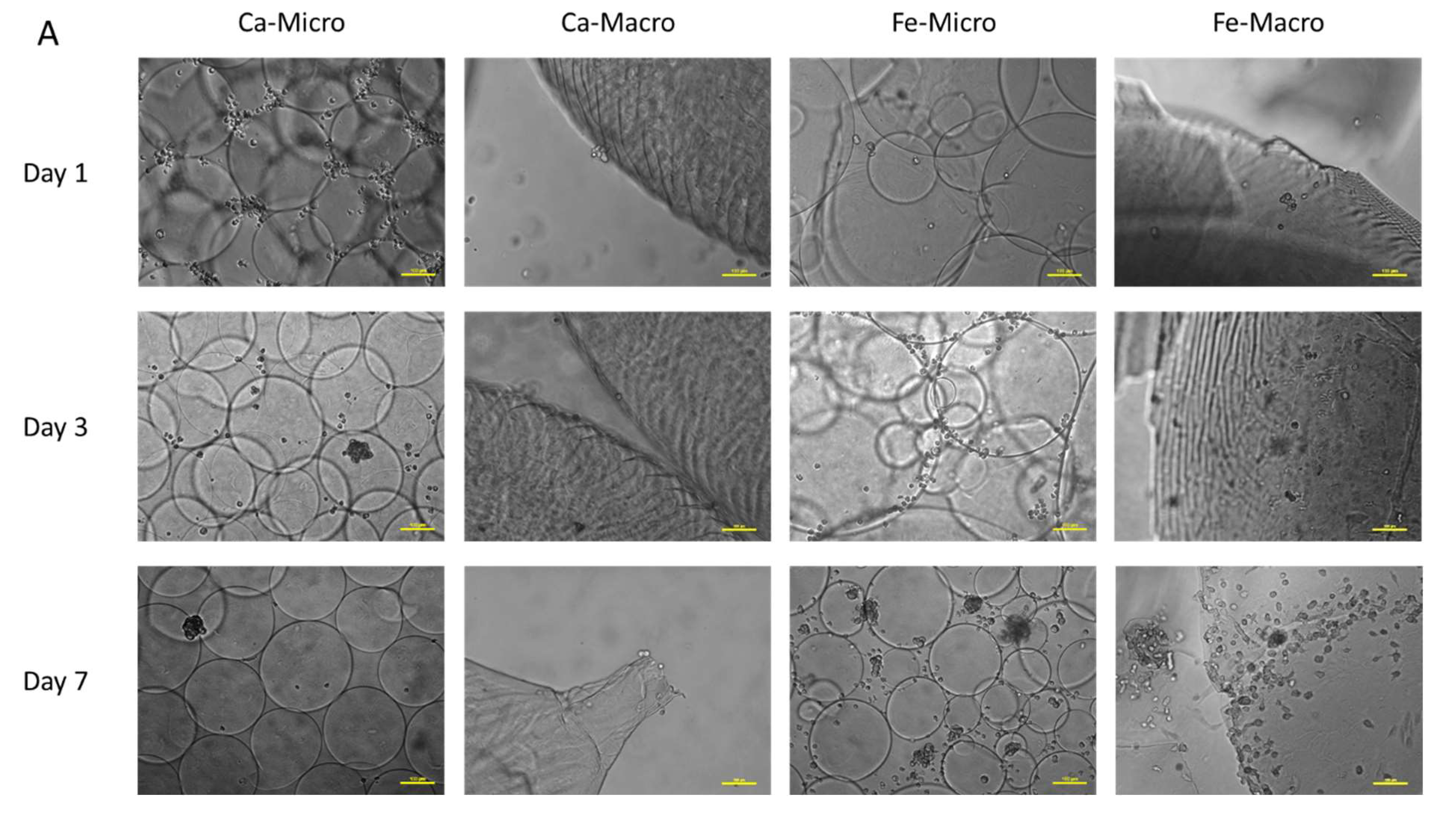

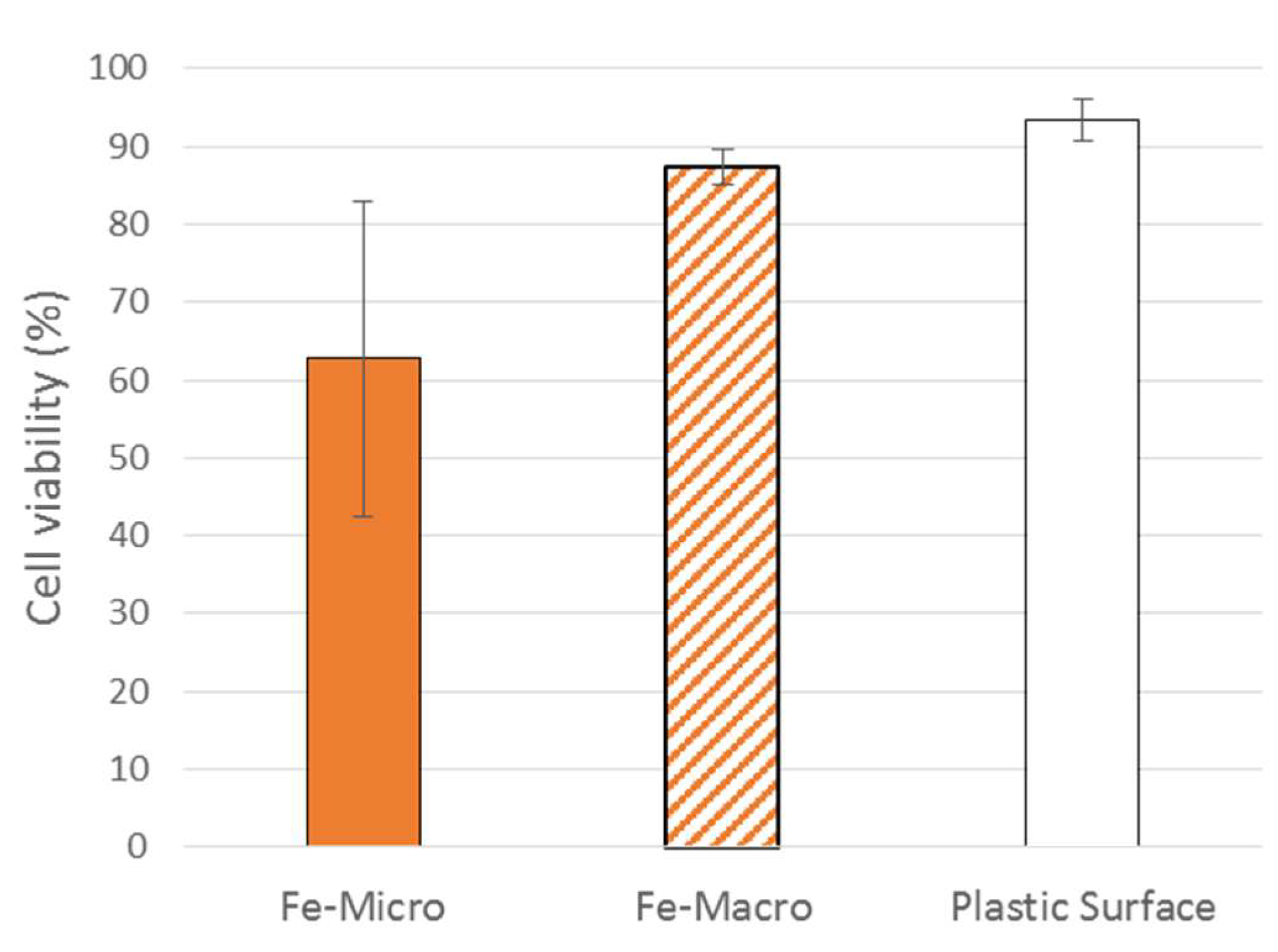
| Crosslinker | Abbreviation | Voltage | Flow Rate | Needle Gauge |
|---|---|---|---|---|
| CALCIUM CHLORIDE | Ca-Micro | 7.5 kV | 3 mL/min | 30G |
| Ca-Macro | / | 3 mL/min | 19G | |
| IRON CHLORIDE | Fe-Micro | 12 kV | 1.7 mL/min | 30G |
| Fe-Macro | / | 3 mL/min | 19G |
Disclaimer/Publisher’s Note: The statements, opinions and data contained in all publications are solely those of the individual author(s) and contributor(s) and not of MDPI and/or the editor(s). MDPI and/or the editor(s) disclaim responsibility for any injury to people or property resulting from any ideas, methods, instructions or products referred to in the content. |
© 2023 by the authors. Licensee MDPI, Basel, Switzerland. This article is an open access article distributed under the terms and conditions of the Creative Commons Attribution (CC BY) license (https://creativecommons.org/licenses/by/4.0/).
Share and Cite
Baudequin, T.; Wee, H.; Cui, Z.; Ye, H. Towards Ready-to-Use Iron-Crosslinked Alginate Beads as Mesenchymal Stem Cell Carriers. Bioengineering 2023, 10, 163. https://doi.org/10.3390/bioengineering10020163
Baudequin T, Wee H, Cui Z, Ye H. Towards Ready-to-Use Iron-Crosslinked Alginate Beads as Mesenchymal Stem Cell Carriers. Bioengineering. 2023; 10(2):163. https://doi.org/10.3390/bioengineering10020163
Chicago/Turabian StyleBaudequin, Timothée, Hazel Wee, Zhanfeng Cui, and Hua Ye. 2023. "Towards Ready-to-Use Iron-Crosslinked Alginate Beads as Mesenchymal Stem Cell Carriers" Bioengineering 10, no. 2: 163. https://doi.org/10.3390/bioengineering10020163
APA StyleBaudequin, T., Wee, H., Cui, Z., & Ye, H. (2023). Towards Ready-to-Use Iron-Crosslinked Alginate Beads as Mesenchymal Stem Cell Carriers. Bioengineering, 10(2), 163. https://doi.org/10.3390/bioengineering10020163










